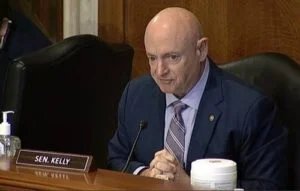WATCH: Sen. Mark Kelly Raises Key Arizona PFAS Issues with EPA Water Official
Today, Arizona Senator Mark Kelly asked EPA Assistant Administrator for Water Radhika Fox about PFAS contamination and how quickly EPA will be able to distribute funds from the bipartisan infrastructure bill for PFAS cleanup in places like Arizona. Growing PFAS plumes in both Phoenix and Tucson have risked the safety of drinking water sources in Arizona’s two largest metropolitan areas.
Earlier this week, the EPA released a strategic roadmap that outlines the agency’s plan to address PFAS contamination in the air, on land, and in drinking water, wastewater, and waterways. The roadmap sets timelines by which EPA plans to take specific actions and commits to new policies to safeguard public health and protect the environment.
PFAS contamination has been a focus of Senator Kelly’s, who raised the issue directly to the EPA Administrator earlier this year, and fought to include funding for PFAS remediation in the bipartisan infrastructure bill that passed the Senate.
Sen. Kelly speaks with EPA Assistant Administrator for Water Radhika Fox at the Environment and Public Works hearing on PFAS on October 20.
To watch Kelly’s full remarks, click HERE.
For a transcript of his remarks and exchange with the witness, see below:
[0:09]: Thank you Mr. Chairman, yeah, in my early days in the Navy, I spent time with the hose and AFFF [Aqueous film forming foam] putting out fires from training, not realizing at the time that that chemical was going to do so much harm to groundwater around the country, so that’s what I want to talk about — PFAS issues.
Thank you Administrator Fox for being here today, it was great talking to you last week, and seeing you again. As you know, Arizona is in the midst of a historic drought. In August, the Bureau of Reclamation declared a Tier 1 shortage on the Colorado River, cutting back on Arizona’s allocation of Colorado River water for the first time ever. While Arizona has spent years making investments to prepare for this, to prepare for a Tier 1 shortage, recent hydrological reports indicate that in the not-too-distant future, we could quickly get to Tier 2 or even Tier 3 of those shortages. This would prompt significant cuts for communities throughout our state.
If these cuts are triggered, communities in Phoenix, and in Tucson, and surrounding areas may have to rely on their secondary source of drinking water – groundwater. Yet, as you know, there are significant – and growing – PFAS plumes in aquifers both in Phoenix and in the Tucson metropolitan areas. These competing challenges makes remediating the PFAS plumes in Arizona’s aquifers an urgent priority. That’s why I fought to include $10 billion in the bipartisan Infrastructure Investment and Jobs Act for PFAS cleanup efforts. While the House still needs to pass the bill, I wanted to ask you today about EPA’s plan for quickly getting this much-needed funding out to states if and when the bill is signed into law. So, Administrator Fox, what can you share about the work your office is doing to prepare to quickly allocate funding provided for PFAS cleanup in the infrastructure bill?
[2:23]: Thank you Senator Kelly for that question. So absolutely, if and when the infrastructure bill is passed, EPA is ready to go. We are having conversations with states you know a lot of the infrastructure money will flow by formula, the SRF formula to states so we are working actively with states to understand what might be their challenges, how do we anticipate and plan for them, how do we make sure projects are ready to go, especially with these carve outs, for the 10 billion for PFAS and the carve out for lead. So, we’re ready to act quickly. We know communities desperately need these resources to ensure they have safe, clean drinking water and reliable wastewater service. I also just want to underscore, Senator, the story you just told about Arizona. It’s so sobering to me, because it shows us the unintended consequences of decisions that we make and why we need a more “one water” approach, right? The fact that this drought situation may leave communities in Arizona to rely on groundwater that’s contaminated with PFAS, that’s just awful right? We need to be attuned to the interconnected nature of these water challenges, it’s why Administrator Regan has charged us with our PFAS roadmap to use every statutory authority to bring our funding and financing programs to bare…not tackle it one PFAS at a time, you know, one chemical or one exposure pathway at a time, so you certainly have our commitment at EPA, that we are ready to act, we are ready to steward resources wisely to communities and that we want to bring a more integrated, comprehensive approach, so that as we make future decisions on water management, that it doesn’t create yet another unintended consequence.
[4:17]: Right, so yeah. Thank you for that, and you know, that is going to help and when we talk about where Arizona is going to be in 2-3 years, the storage, the water in Lake Mead went down 10% in a year, it’s at 30% and Arizona gets 40% of its water from the Colorado River, it’s at 1067 feet above sea level, when it gets to 1050, which is possible in a year or two, then we are in tier 2 then we are in the situation where we have to rely on groundwater for drinking water and the PFAS plumes, the one in Tucson by the way got so significant that the facility to take the PFAS out of the water was overwhelmed by too much PFAS, couldn’t do it, had to shut down, so I appreciate the Administrator’s focus on this. It is critically important that we get these funds – as soon as the bill is passed – that we get these funds to Arizona to start this remediation. Thank you.

